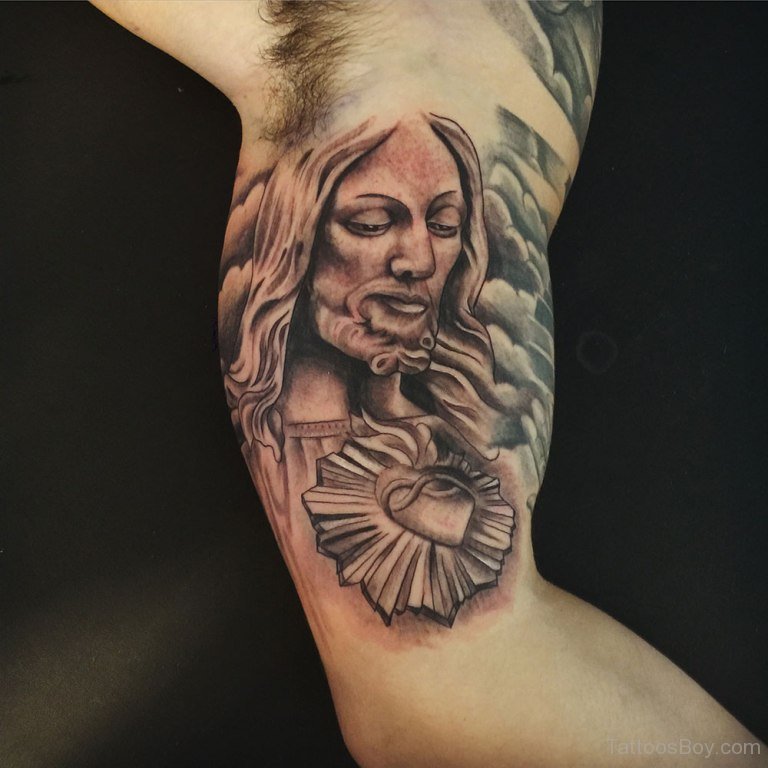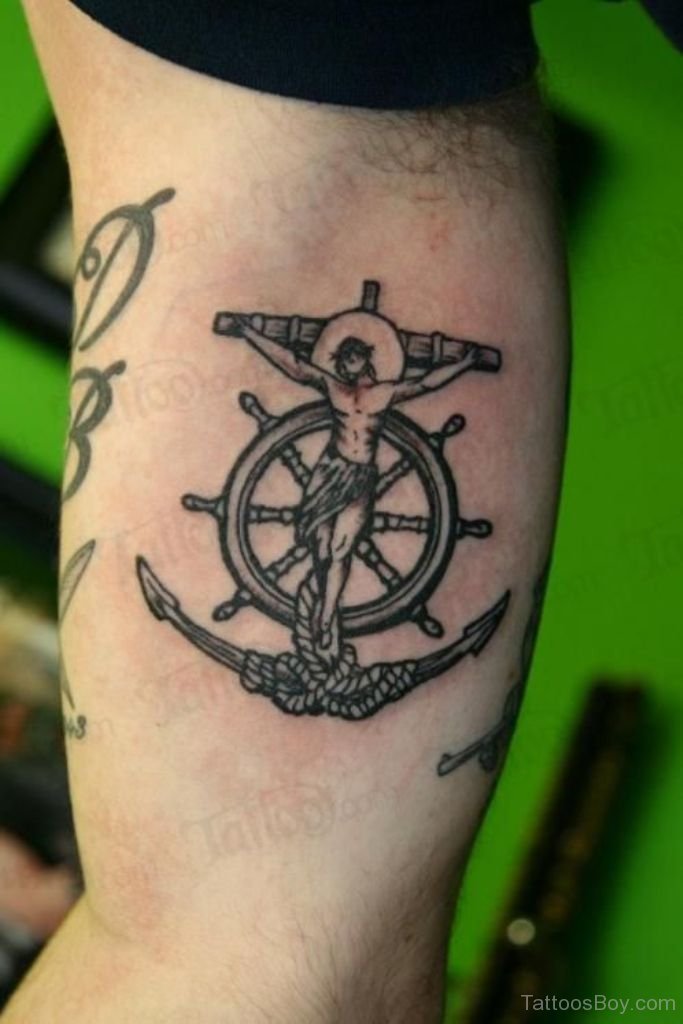Religious bicep tattoos have become a powerful way for individuals to express their faith, inner strength, and personal beliefs through body art. Whether you're someone who deeply values spirituality or simply appreciates meaningful designs, these tattoos offer more than just aesthetics—they tell a story. From intricate crosses to symbolic imagery, these tattoos serve as a reminder of one’s connection to a higher power while showcasing strength and devotion.
In today’s world, tattoos are no longer seen as taboo but as an extension of one’s identity. Religious bicep tattoos, in particular, have gained popularity because they combine faith with the physical representation of power and resilience. For many, the bicep is a perfect canvas to display symbols that hold deep meaning, making it an ideal choice for those looking to honor their beliefs.
This article dives deep into the world of religious bicep tattoos, exploring their significance, popular designs, cultural impact, and how to choose the perfect design for you. If you're considering getting inked or just curious about this unique form of body art, stick around—we’ve got all the info you need!
Read also:Discovering The Multifaceted Imogen Faith Reid
Table of Contents
- The History of Religious Tattoos
- Significance of Religious Bicep Tattoos
- Popular Religious Bicep Tattoo Designs
- How to Choose the Right Design
- Cultural Impact of Religious Tattoos
- Care Tips for Your Religious Tattoo
- Cost Considerations
- Current Trends in Religious Tattoos
- Frequently Asked Questions
- Final Thoughts
The History of Religious Tattoos
Religious tattoos have been around for centuries, dating back to ancient civilizations where body art was used to signify devotion, protection, and spiritual connection. In cultures like Egypt, Greece, and even early Christianity, tattoos played a significant role in religious practices. For instance, early Christians often tattooed themselves with crosses or other sacred symbols as a way to publicly declare their faith.
Fast forward to modern times, and the concept hasn’t changed much. People still use tattoos to express their spirituality, but now there’s more variety in design and placement. The bicep, being one of the most visible and muscular parts of the body, has become a popular spot for religious tattoos. It’s like saying, “I’m strong in my faith, and I’m proud of it.”
Evolution of Religious Body Art
Over the years, religious tattoos have evolved from simple crosses to complex, artistic pieces that incorporate elements like roses, doves, and even scripture. This evolution reflects the growing acceptance of tattoos in mainstream society and the desire for personalized, meaningful art. Artists today are pushing boundaries by blending traditional religious symbols with modern aesthetics, creating pieces that resonate with contemporary audiences.
Significance of Religious Bicep Tattoos
Religious bicep tattoos carry immense significance for those who wear them. They represent not only faith but also strength, courage, and resilience. By choosing to place a religious symbol on such a prominent part of the body, individuals are making a bold statement about their beliefs and values.
For some, these tattoos serve as a constant reminder of their faith, offering comfort and guidance during challenging times. Others view them as a tribute to loved ones or a celebration of their spiritual journey. Whatever the reason, religious bicep tattoos are deeply personal and hold a special place in the hearts of those who wear them.
Why the Bicep?
The bicep is often chosen because it’s a strong, muscular area that can support larger, more detailed designs. Plus, it’s easily visible, making it a great canvas for showcasing your faith. Think about it—when you flex your arm, that tattoo becomes even more prominent, almost like it’s coming alive. It’s a powerful way to express yourself without saying a word.
Read also:Tatum O'neal Mother
Popular Religious Bicep Tattoo Designs
When it comes to religious bicep tattoos, the design options are endless. From classic crosses to elaborate scenes, here are some of the most popular choices:
- Crosses: The most common religious symbol, crosses come in various styles, from minimalist to ornate.
- Roses and Thorns: Often paired with a cross, this design represents the beauty and pain of faith.
- Doves: Symbolizing peace and purity, doves are a popular choice for religious tattoos.
- Scripture: Incorporating Bible verses or other sacred texts adds a personal touch to any design.
- Angels: These heavenly beings are often depicted in religious tattoos to symbolize protection and guidance.
Each design carries its own meaning, so it’s important to choose one that resonates with you and your beliefs.
Customizing Your Tattoo
Don’t be afraid to get creative with your design! Many people opt to incorporate personal elements, such as family names, dates, or symbols that hold special meaning to them. This not only makes the tattoo unique but also adds an extra layer of significance. Just remember to work closely with your tattoo artist to ensure the final piece reflects your vision.
How to Choose the Right Design
Choosing the right design for your religious bicep tattoo can be overwhelming, especially with so many options available. Here are a few tips to help you make the best decision:
- Consider Your Beliefs: Think about what aspects of your faith you want to highlight in the tattoo.
- Research Designs: Look at different styles and see what appeals to you. Pinterest and Instagram are great resources for inspiration.
- Consult Your Artist: A skilled tattoo artist can help you refine your ideas and suggest ways to enhance the design.
- Think About Placement: The bicep offers plenty of space, but consider how the design will look on your body and whether it will be easily visible.
Remember, this is a lifelong commitment, so take your time and choose wisely. You want a tattoo that you’ll love and cherish for years to come.
Cultural Impact of Religious Tattoos
Religious tattoos have had a profound impact on culture, both historically and in modern times. They’ve helped bridge gaps between different faiths and communities, fostering understanding and respect. In some cultures, religious tattoos are seen as a rite of passage or a mark of identity, connecting individuals to their heritage and traditions.
However, it’s important to approach religious tattoos with sensitivity and respect. Some symbols hold deep cultural significance, and using them without understanding their meaning can be disrespectful. Always do your research and consult with experts if you’re unsure about a particular design.
Breaking Stereotypes
One of the most exciting things about religious tattoos is how they’re helping to break down stereotypes. In the past, tattoos were often associated with rebellion or criminality, but today, they’re seen as a legitimate form of self-expression. Religious tattoos, in particular, challenge these outdated perceptions by showcasing faith and devotion in a beautiful, artistic way.
Care Tips for Your Religious Tattoo
Once you’ve gotten your religious bicep tattoo, it’s crucial to take good care of it to ensure it heals properly and looks great for years to come. Here are some care tips to keep in mind:
- Keep It Clean: Wash the tattoo gently with mild soap and water, following your artist’s instructions.
- Moisturize: Use a fragrance-free moisturizer to keep the skin hydrated and prevent cracking.
- Avoid Sun Exposure: Protect your tattoo from direct sunlight, especially during the healing process.
- Don’t Pick or Scratch: This can damage the tattoo and cause scarring.
By following these tips, you’ll ensure your tattoo remains vibrant and meaningful for years to come.
Cost Considerations
The cost of a religious bicep tattoo can vary depending on several factors, including the size, complexity, and location of the design. On average, you can expect to pay anywhere from $100 to $500 or more for a high-quality tattoo. It’s important to remember that cheaper isn’t always better—investing in a skilled artist will ensure you get a tattoo that meets your expectations.
Many tattoo artists offer consultations where you can discuss your design, budget, and other concerns. Take advantage of this opportunity to ask questions and get a better understanding of the costs involved.
Current Trends in Religious Tattoos
Religious tattoos continue to evolve with new trends emerging all the time. Some of the current trends include:
- Watercolor Designs: These vibrant, flowing tattoos add a modern twist to traditional religious symbols.
- Minimalist Styles: Simple, clean lines are becoming increasingly popular for those who prefer a subtler look.
- Blackwork Tattoos: Bold, black ink designs are making a comeback, offering a dramatic and striking appearance.
These trends reflect the growing diversity in religious tattoo art, allowing individuals to express their faith in unique and creative ways.
Frequently Asked Questions
Here are some common questions people have about religious bicep tattoos:
- Do religious tattoos hurt more than other tattoos? Pain levels vary depending on the person and the design, but the bicep is generally considered a less painful area for tattooing.
- Can I change the design later? While it’s possible to modify or cover up a tattoo, it’s best to choose a design you’ll be happy with long-term.
- Are religious tattoos accepted in all cultures? Cultural acceptance varies, so it’s important to research and understand the significance of certain symbols before getting inked.
Final Thoughts
Religious bicep tattoos offer a powerful way to express your faith, strength, and personal beliefs. Whether you choose a classic cross or a more elaborate design, these tattoos allow you to carry your spirituality with you wherever you go. By carefully selecting a design and working with a skilled artist, you can create a piece of art that truly reflects who you are.
So, if you’re thinking about getting a religious bicep tattoo, don’t hesitate! Do your research, choose a design that speaks to you, and embrace the journey of turning your body into a canvas of faith and art. And hey, don’t forget to share your story with us in the comments below—we’d love to hear about your experience!


